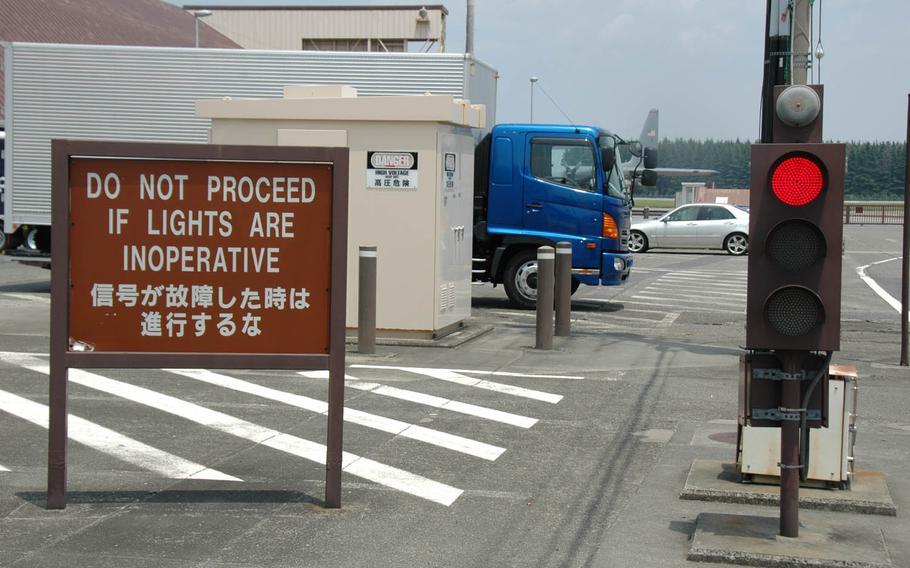
Motorists at Yokota Air Base, Japan, headquarters of U.S. Forces Japan and 5th Air Force in western Tokyo, must wait to cross the flight-line when aircraft take off and land. Drivers are also warned to watch out for jet exhaust and to yield to low-flying aircraft. (Seth Robson/Stars and Stripes)
YOKOTA AIR BASE, Japan — Living near an airport can mean inconveniences like loud noise and traffic. Then there’s Yokota, where just going to the commissary can get you stuck a few yards from the runway in a cloud of jet fuel fumes while waiting for a plane to take off or land.
“Because of limited space, drivers cross an active runway at both the north and south sides of the base,” said Tech Sgt. Charmaine Johnson, an air traffic controller with Yokota’s 374th Airlift Wing who probably gets cursed regularly by drivers trying to avoid being late for work or wanting to get home before dinner gets cold.
Lights control ground traffic crossing the runway, where, at any given time, one of the wing’s C-130 Hercules transports might be landing or taking off from Yokota, headquarters of U.S. Forces Japan and the 5th Air Force in western Tokyo.
The wing also operates C-12 passenger planes and UH-1 “Huey” helicopters, and the base hosts commercial Boeing 747 cargo planes, Marine Corps V-22 Osprey tilt-rotor aircraft and large C-17 and C-5 transports. F-22 Raptors and F-16 jet fighters have visited this year.
When Yokota’s flight-line is clear, drivers approaching its overruns see yellow lights alerting them to proceed with caution. But when an aircraft starts its takeoff roll or an arriving plane is 6 miles away, the light turns red and an alarm rings, warning drivers to stop, Johnson said.
Traffic resumes once a departing plane climbs to 1,000 feet or an arriving aircraft lands. The air traffic controllers operate the stop lights using buttons in the control tower, Johnson said.
During “touch and go” training at Yokota, pilots repeatedly take off and land without coming to a full stop, and traffic trying to cross the flight-line can be blocked for long periods, Johnson said.
“Sometimes we’ll have to keep the lights on from five to 20 minutes, and then people complain,” he said.
Justin Williams, who works at a Subway sandwich shop on Yokota’s east side, said there are plenty of challenges to operating a vehicle in Japan, such as driving on the left side of the road, a large number of cyclists and narrow streets.
“Driving across the flight-line was just one more thing to get used to,” he said. “[The stop light] only seems to go off when I’m already late for work, so I’m even later.”
Another quirk is that drivers can’t stop or turn around once they start the approach to the flight line and have the right-of-way over pedestrians and bicyclists, who are limited to a narrow asphalt path that crosses the road at three places.
Frustrated residents have offered suggestions, such as building a tunnel under the runway, or perhaps a new road. The Air Force says such alterations would be expensive and aren’t planned.
“The most common complaint we receive is that the system exists at all,” Johnson said. “But the system is for your safety. Please stop at the traffic light.”
Without the warning system, the only way to cross the base would involve traveling outside the installation — a daunting task in Tokyo’s often gridlocked traffic.
Yokota isn’t the only place where Air Force planes and civilian ground vehicles share the tarmac. Last month, four Air Force A-10 jets landed on a highway in Estonia during training that hadn’t been done since 1984. During the Cold War, it was assumed that military airfields would be destroyed by the Soviets in a conflict.